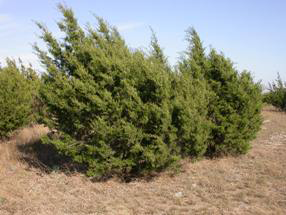Ashe's juniper was named in honor or William Willard Ashe (1872-1932) who was a pioneer forester of the U.S. Forest Service and collected a specimen of this plant in Arkansas. The wood of Juniperus ashei is often used for fence posts due to its durability and resistance to rot. The peeling strips of bark from Ashe's juniper are used by birds for nesting material, most notably the endangered golden-cheeked warbler. This plant is known colloquially as “cedar” throughout much of its range and is a source of agony for many allergy-sufferers when its pollen is released during the winter months.
Photo Credit: © Estelle Levetin, University of Tulsa
Juniperus ashei
Common Name: Ashe's juniper
Plant Functional Group: Evergreen conifer
Class > Order > Family: Pinopsida > Pinales > Cupressaceae
What does the species look like?
Ashe's juniper is an evergreen, conifer tree growing 33 to 40 feet tall. Male and female cones occur on separate trees. Its male cones are small, yellow, and inconspicuous, and bear pollen. Its female cones are small, berry-like, and wind- pollinated, and mature in one year.
Ashe's juniper is typically found on soils that have been derived from limestone. It is common in lower elevation oak-cedar savannas and prairie margins. It is a highly drought-tolerant plant.
Where is the species found?
States & Provinces
AR, MO, OK, TX
Which phenophases should I observe?
Do you see...?
Pollen cones
Pollen cones
View Phenophase Image More...
How many fresh pollen cones are present?
Less than 3 3 to 10 11 to 100 101 to 1,000 1,001 to 10,000 More than 10,000
Open pollen cones
View Phenophase Image What percentage of all fresh pollen cones (unopened plus open) on the plant are open?
Less than 5% 5-24% 25-49% 50-74% 75-94% 95% or more
Pollen release More...
How much pollen is released?
Little: Only a few grains are released. Some: Many grains are released. Lots: A layer of pollen covers your palm, or a cloud of pollen can be seen in the air when the wind blows
Seed cones
Unripe seed cones Juniperus ashei , an unripe seed cone is berry-like and green, turning pinkish, often covered with a whitish film that rubs off.More...
How many seed cones are unripe?
Less than 3 3 to 10 11 to 100 101 to 1,000 1,001 to 10,000 More than 10,000
Ripe seed cones
View Phenophase Image Juniperus ashei , a berry-like seed cone is considered ripe when it has turned dark blue or purple, often covered with a whitish film that rubs off.More...
How many seed cones are ripe?
Less than 3 3 to 10 11 to 100 101 to 1,000 1,001 to 10,000 More than 10,000
Recent cone or seed drop More...
How many seed cones have dropped seeds or have completely dropped or been removed from the plant since your last visit?
Less than 3 3 to 10 11 to 100 101 to 1,000 1,001 to 10,000 More than 10,000
What do these phenophases look like?
The following Phenophase Photo Guides for this species have been vetted for accuracy by the USA-NPN National Coordinating Office. Most photo guides are developed for a particular local or regional monitoring effort, and some of the content may not apply to your effort or your region. However, we make them available to provide as much help as they may in illustrating phenophases for this species. If you have high quality phenophase photos that you are willing to share with us, please visit the Phenophase Photo Guidelines page.
Be aware there is variation from individual to individual within a species, especially across different regions, so your plant may not look exactly like the one pictured.
Since they do not always include complete definitions for the species, use these photo guides ONLY in conjunction with the official Nature's Notebook phenophase defintions included in the table above, in the phenophase definition sheet that downloads with the datasheet, or in the Observe screen in the mobile app.
